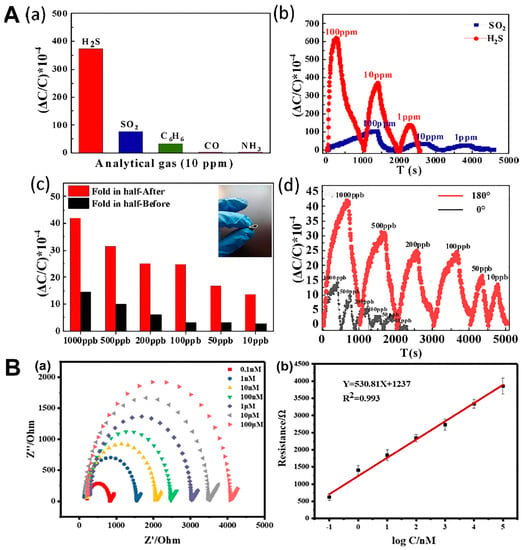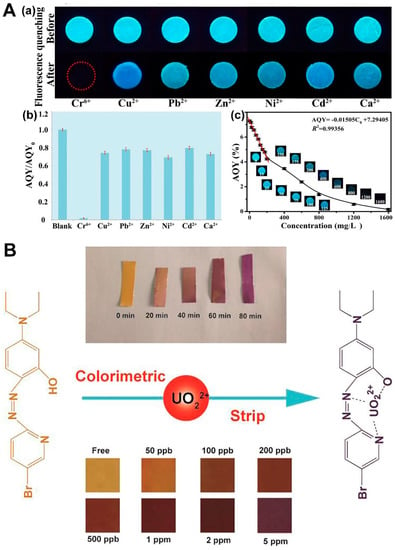© Copyright 2020 Foshan Membrane Technology Co., Ltd. All rights reserved. Sitemap
With the development of nanotechnology, nanomaterials such as MIPs, QDs, NPs, MOFs, graphene, nanotubes, and NFs are increasingly being used as sensor platforms in various sample detection fields, including biomedical, food safety, and environmental pollution . As a chemical-sensing platform, NFs use electrochemical and optical detection methods to greatly accelerate the sensing response time and field detection efficiency, with increasing detection range and sensitivity . Therefore, NFs have high application prospects in chemosensors for high-precision qualitative and quantitative detection of environmental pollution. The sensor detection performance usually includes sensitivity, selectivity, detection limit (LOD), repeatability, response, and recovery time, among which good sensitivity and linear response are the keys to preparing sensors. The development of nanomaterials can effectively improve the sensor detection performance.
In chemosensors, the principle can be divided into electrochemical and optical sensors. The detection principle of electrochemical sensor is based on the measured substance in the process of electrochemical sensor surface reaction, using the recognition element induction in electrochemical sensor surface and substrate combined to produce a certain biological or chemical quantity; then, through the signal converter, according to a certain rule, a quantitative electrical signal (such as current, potential difference, or conductance properties) can be programmed so as to achieve the purpose of analysis and monitoring. The change and the concentration of the substance to be analyzed are proportional to the quantitative analysis of the analyte [123,140,141,142,143,144]. Compared with traditional methods, the electrochemical sensor has many advantages, such as high sensitivity, a short response time, simple operation, the ability to monitor online in complex systems, and the ability to remove other analytes without the need for pretreatment, making it a unique analytical method for environmental pollution detection [145,146]. Electrochemical sensors usually use the following methods to detect environmental pollutants, namely voltammetry, amperometry, and the impedance method [143,147]. In the voltammetry method, the test substance is easily directly oxidized or reduced on the working electrode to obtain a specific oxidation-reduction potential for qualitative analysis with good selectivity [148]. The amperometry method can quantitatively analyze the concentration of the test substance by generating a specified potential through the electrolytic current [149]. The change in impedance caused by different concentrations of the test substance on the electrode surface can show a micro linear range with a low detection limit [140]. Zhang et al. prepared flexible hydrogen sulfide (H2S) sensors, using electrospun NFs coated with a porous MOF that can detect ultralow concentrations of the gas [52]. Specifically, the researchers utilized electrospun polyvinylidene fluoride (PVDF) NFs as a substrate to grow NO2-UiO-66, a type of MOF, resulting in a sensitive and selective H2S sensor. Electrospinning provides a large surface area for the growth of the MOF and improves the sensitivity of the sensor. The article highlights the significance of electrospinning in sensor manufacturing and proposes that this innovative technique could pave the way for the creation of flexible gas sensors with environmental applications (Figure 3A). Song et al. prepared a sensor made of a carbon nanofiber modified with an MOF made of iron (Fe) [41]. The resulting NFs had a high surface area-to-volume ratio, and the Fe-based MOF was used to modify the surface of the carbon NFs, which enhanced the selectivity and sensitivity of the sensor. The article provides a detailed analysis of the material mechanism of electrospun NFs and the electrochemical behavior of the sensor, which can be useful for designing and fabricating other electrochemical sensors (Figure 3B).

1.1. Application of electrochemical detection sensors in environmental pollution. (A) (a) Evaluation of the selectivity of the NO2-UiO-66 nanomaterial sensor toward H2S. (b) Detection of varying concentrations of H2S and SO2, using the NO2-UiO-66 nanomaterial sensor. (c) Analysis of the capacitive variations exhibited by the sensor under normal conditions and when subjected to 180° bending. (d) Investigation of the cyclic stability of the sensor for different concentrations of H2S while subjected to bending (reproduced with permission from [52], copyright © 2022, Elsevier). (B) (a) Investigation of the impedance responses of the aptasensor toward various concentrations of TC, using EIS. (b) Generation of a calibration curve for the quantitative detection of TC, using the aptasensor (reproduced with permission from [41], copyright © 2022, Elsevier).
In the case of chemosensors, according to the principle, they can be divided into the fluorescence method and colorimetric method. The chemosensors based on the fluorescence method have the characteristics of a short response time, selectivity, and a wide detection range. Its basic principle is the specific interaction between the biomolecules on the sensor and the object to be analyzed [4,150,151,152,153,154,155,156]. The light signal formed by absorption or emission band changes resulting from chemical interactions is easily detected by fluorescent molecules, with the light signal correlated with the concentration of the analyte [157,158,159,160,161,162,163,164,165]. Nanomaterials are widely used as probe indicators in various chemical tests due to their high sensitivity, wide detection range, and convenient operation. Han et al. prepared a novel fluorescent hydrogel for the efficient adsorption and detection of hexavalent chromium (Cr(VI)) [159]. The hydrogel was created by blending lignin, cellulose nanofibers (NFs), and carbon dots and subjecting them to electrospinning to confer fluorescence properties for detection purposes. The hydrogel exhibited a high adsorption capacity for Cr(VI) and demonstrated high sensitivity in detecting its presence through fluorescence spectroscopy. The electrospinning technology played a crucial role in developing this innovative hydrogel due to the resulting high surface area and porosity of the material (Figure 4A). Colorimetric detection is widely accepted as a selective and highly sensitive method for detecting various analytes, making it suitable for the rapid and simple detection of environmental pollution. Due to its simplicity, ease of operation, and fast field detection, colorimetric technology is currently moving toward miniaturization without additional cost. The development of chromogenic materials and their colorimetric sensing mechanism is a key research direction in the development of nanomaterials, which have played a crucial role in optical sensing equipment [159,160,161,162,163,164]. Chromogenic materials include organic materials (based on chelation reaction, self-catalyzed reaction, and enzyme-mimetic reaction), inorganic materials (based on local surface plasmon resonance, QDs and MOFs), and other materials (such as photonic crystals) [165,166,167,168,169]. Hu et al. modified fibrous acid NFs that were prepared by electrospinning technology, using 2-(5-Bromo-2-pyridylazo)-5-(diethylamino) phenol (Br-PADAP) as a color developer for the quantitative detection of uranyl (UO22+) by visual colorimetric sensing [170]. Cellulose acetate (CA) NFs were used as a matrix for immobilizing Br-PADAP, making the sensor highly portable and stable. The BR-PAPAP embedded in the fiber can interact strongly with UO22+, which perturbs the BR-PAPAP backbone and causes color changes (Figure 4B). With the advancement of technology, smartphone-assisted colorimetric readers, which combine readout devices with colorimetric methods, have a wide range of applications in sensor applications [43,44]. In the following sections, we mainly focus on the principle of electrochemical sensing and optical sensing and discuss the research on electrospinning technology in the field of chemical sensing for environmental detection, as well as the advantages of different structured NFs in improving sensing performance.
Article Source: https://www.mdpi.com/2227-9040/11/4/208

Figure 4. Application of optical detection sensors in environmental pollution. (A) (a) After adding different metal ions at a concentration of 2000 mg/L, the lignin-based hydrogel exhibited changes in its fluorescent properties. (b) The addition of various heavy metals caused the AQY (absolute quantum yield) of FLH-3, a hydrogel made from lignin, to vary. (c) The concentration of Cr(VI) had a gradual effect on the fluorescence of FLH-3, resulting in a decrease over time (reproduced with permission from [159], copyright © 2021, Elsevier). (B) The process of complex formation with uranyl ions, the duration required for colorimetric detection in photographs, and the optical colorimetric response of Br-PADAP/CA NFs at varying concentrations of UO22+ (reproduced with permission from [170], copyright © 2017, Elsevier).
Article Source: https://www.mdpi.com/2227-9040/11/4/208